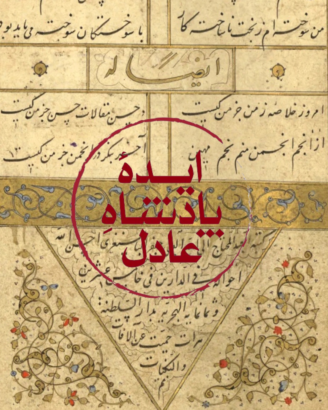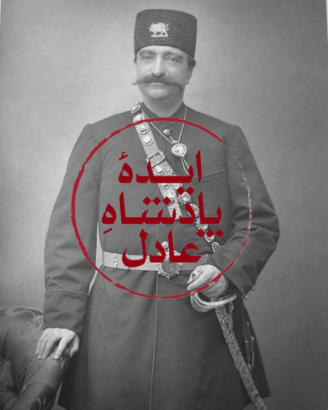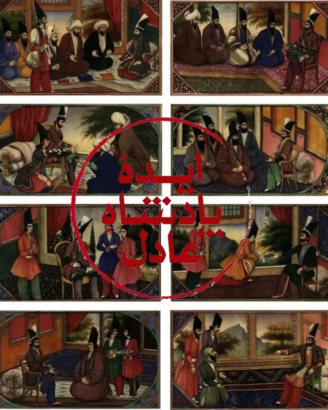The 17th century was a period of deep transition for the arts of the book in Iran. While manuscripts had long been the preferred support for displaying artistic excellence, the spread of album paintings (مرقع) from the 1600s onwards, which are substantially quicker and more affordable to produce, along with the development of frescoes, lacquer, and other media offered painters new possibilities to express their talent resulting in a significant drop in manuscript production. However, over a period of roughly 50 years (1648-1693), one notices a short revival of exquisite non-royal illustrated manuscripts that take as subject the epic of Shahnama written by Abu’l Qasem Ferdowsi. The phenomenon even appears to be intense as 17 manuscripts signed by several A-scale painters from the Isfahan school have been cataloged to date (see appendix), of which more than half are exclusively signed or attributed (6 signed, 3 attributed) to the master painter and famous pupil of Reza-ye ‘Abbasi, Mu’in Musavvir (active 1635-1693). The corpus shows stylistic consistency, but one is left surprised by the variable quality of the images. Some display the utmost quality that would suggest Court orders, whereas others show repetitive and smaller compositions with an overall lesser quality. Therefore, this study intends to define the targeted audience of these books and the reasons behind the sudden desirability of Ferdowsi’s epic around 1650 in connection with Mu’in Musavvir.
Towards a new type of patronage
In Iran, economic and political prosperity systematically encouraged the development of the arts and an active dynamic of book patronage. Ferdowsi’s epic was a particularly suitable theme as it was a way to extol the Iranian identity and convey a relevant message about power and authority through stories highlighting the achievements of Iranian kings and heroes[1]. The characters mentioned in the story are both mythological and historical, so it not only represents a founding story but also an important chronological landmark. This cultural importance encouraged every king and prince from at least the fourteenth century under the Ilkhanid dynasty to commission a version of the text, establishing henceforth a royal tradition of illustrated Shahnamas (Great Mongol Shahnama, the so-called “Small Shahnamas”, Shahnama Baysongori, Tahmasp Shahnama, Shahnama of Ismail II,..). Ensuring that the text was copied and illustrated was also a way for rulers to promote and display artistic excellence through orders made to the court artists working in the royal workshops as patronage was mostly a royal privilege until the end of the 16th century[2]. As the Safavid historian Eskandar Beg Munshi and the French traveler Jean Chardin pointed out, painters who were hired in the ketâb khâneh/nâqqash khâneh often represented the best elements of their guild and were better valued, both in terms of recognition and money in comparison to their fellows working in the bazaar’s guilds (asnaf)[3]. Chardin counted for instance 72 painters of great talent in the naqqâsh khâneh of ‘Abbâs II when he visited Isfahan in 1666 but added that they were “little demanded for royal orders” and that he had “seen some without commission from the king for three or four years in a row[4]. This Western point of view expressed by Jean Chardin met the complaint of the painter Muhammad Qasim (1575-1659) who stated that “no one pays [them] [their]due measure, no one knows [their]situation. After death, like a white worm, the pearl of [their] fame shall grow”.
امروز نداد /کس اندازه ما
کس را/ نٰبُوٰد خبر/ زِ شیرازه ما
خواهد گشتن بلند/ بعد از مردن
چون کرمِ سفید/ آوازه ما[5]
Muhammad Qasim belonged to the Isfahan school alongside Mu’in Musavvir and was recorded in the painting workshop of ‘Abbâs I, Safi, and ‘Abbâs II until the late 1640s. Based on his observation, the lack of royal commissions had particularly detrimental consequences on the condition of the artists. These almost contemporary views reveal the tipping point that occurred in the 17th century regarding the arts of the book. From the reign of Shâh ‘Abbâs I onwards and unlike previous generations, manuscripts commissions tended to be less numerous. While a fragmentary Shahnama of 21 folios and sixteen paintings was started in 1590 upon Shâh ‘Abbas I’s coronation, it was left unfinished before being completed by various artists in 1675 only. This trend was further confirmed under his son Safi I and his grandson ‘Abbâs II as no manuscript or Shahnama referenced to date was of royal pedigree.
On this question, one faces the scarcity of coherent information in the sources, but one can legitimately argue that the durability of the orders of illustrated Shahnamas lies above all in the belief of their relevance regarding the “royal message” they convey. Moreover, and in contrast to other royal workshops, the ketâb khâneh/nâqqash khâneh is a possession intimately linked to the sovereign (khassa), not to the state (mamalik). Accordingly, it isn’t automatically handed down but is set or undone based on the bookish projects and on the tastes of the ruler[6]. A decline in its activity is therefore considered direct evidence of a lack of relevance in the king’s eyes. This shift had a direct impact on artists in the royal workshops. As Jean Chardin further noted, in the absence of royal input, artists were “free to work for themselves and for whoever employs them, which implies they were let free to evolve outside of the royal structure[7]. Such practice wasn’t new and we recall for instance Sadiqi Beg Afshar, painter, and chief of the ketâb khâneh from 1587 to 1598 under ‘Abbas 1 looking for merchants to sell his drawings on the bazaar’s stalls. Nonetheless, this phenomenon became more frequent as the seventeenth century went on[8]. As for Mu’in Musavvir, details about his career aren’t defined precisely. Even though his participation in the 1640’s fresco cycles in the palace of Chehel Sotun in Isfahan along with other students of Reza Abbasi shouldn’t be completely ruled out based on a stylistic analysis and would suggest links with the Court, he wasn’t formally mentioned in the registers of the artists being employed in the royal workshops. For this reason, the extent of his connection with it and his actual role regarding some royal projects remains yet speculative. However, considering the important number of album paintings he produced from the 1650s onwards, one should not doubt his ability to evolve as an independent artist and find other protectors. The portraits he painted of ‘Abbâs II’s two great vizirs, Saru Taqi and Kalifa Soltân, Nazar ‘Ali Beg, the court physicist Hakim Shafa’i or navvâb Mirza Muhammad-Bakir, an astrologer in the service of Shâh ‘Abbâs II, give a hint about the overall identity of the first-class individuals who might have hired him and reflect the change that happened in the middle of the century regarding the identities of patrons more broadly.
Around 1650, reform policies first implemented by Shah ‘Abbâs I, subsequently continued under Safi and Abbas II’ completed the replacement of the traditional Safavid elite originally composed of Turcoman lords (Qizilbâsh). Until the end of the 16th century, Qizilbâsh individuals formed the core of the Safavid state and helped militarily the king in exchange for political power. Many of them, for instance, obtained the governance of Iranian provinces or held high positions within the administration. But the balance of power gradually changed as Ghulams began to replace them as the leading force. Ghulams were converted slaves of Armenian, Georgian, and Circassian origins who had been captured by ‘Abbas I during military campaigns and put at the disposal of the sovereign, whether in his private guard (ghulâmân-e khâssa-ye sharîfa) or at the head of high positions within the army or the administration. One can mention for instance Allahverdi Khan (1560-1613) who was the first of his kind to be appointed governor of the province of Fars in 1595, the Qarajaghay family of Armenian descent, which gained in importance in the province of Mashhad and gave several governors to the city[9] or Saru Taqi (1579-1645), governor of the provinces of Mazandaran and Gilan then made great vizir of Safi I and ‘Abbas II until his murder in 1645[10]. Just like the Qarajaghay family, Ghulams often were at the origin of “dynasties” whose administrative functions and privileges were inherited by their successors, empowering them significantly as the generations went on and turning them into major actors within the Safavid State[11]. Consequently, they constituted a category of particularly influential people along with other State Officials and benefited from the gradual gentrification related to their new social status. It was then made possible for them to indulge in a patronage enterprise and while this activity was neither new nor unusual among members of the elite, for the newly converted however, artistic patronage must have played an important role in raising their standing and inscribe their self in Isfahan’s artistic milieu.
As the scholar Sussan Babaie pointed out, when funded from the individual’s purse, the privilege of patronage, its extolling of the patron’s piety, power, and prestige, not to mention the legal protections of family fortunes under charitable stipulations (waqf) was valued and advertised[12]. Hence, as their counterparts had done, Ghulams too exploited its potentialities. Furthermore, what is striking is the monopoly in this activity of the latter on the former. Some of them called upon artists previously employed by the Court and set up their independent ketâb khâneh such as the Qarajaghay family that participated in the creation of a Mashhad School of painting by hiring Muhammad Qasim and Muhammad Yusuf[13]. Thus, the decline in court commissions was not necessarily synonymous with a decline in book production as one might expect. The intrinsic prestige of classical texts and probably also the desire to emulate what was traditionally done, motivated ghulams and other members of the elite to commission manuscripts of a notorious refinement. By a mimicry effect, they would also place themselves as guarantors of the Iranian identity through their books.
Now, regarding the corpus of Shahnamas associated with Mu’in Musavvir, except for the one finished in 1650 now stored in the David Collection in Copenhagen and reading the name of a certain navvâb Abu’l-Mahdi Husain in the colophon, patrons are largely unknown. However, considering the context in Isfahan around 1650, one can strongly suggest that these were commissioned by state officials and Ghulams[14]. As for the Shahnama made for Abu’l-Mahdi Husain, the historian Iraj Afshar (1925-2011) linked him with a certain Mirza Shâh Abu’l Mahdi, owner of a large garden near the city of Yazd. Afshar further suggested that he could be identified with a vizier who financed the construction of a building in 1064/163-1655 in the same city and who was of ghulam descent[15]. The real position of Abu’lMahdi Husain is yet open to debate, but he likely held a prominent role and was wealthy enough to commission a Shahnama with 42 paintings of very fine quality from one of the leading painters of the time. Besides, being able to attract a Yazdi patron means for Mu’in Musavvir that he was a sought-after painter whose reputation spread way beyond the walls of Isfahan.
The taste for Mu’in Musavvir
Mu’in’s attractiveness must be understood through the specificities of his brush, which differs substantially from one of his fellows. The seventeenth century is indeed a period of strong competition among artists, and the development of a personal style allowed one to visually associate a brush with an artist. The individualization of Mu’in’s brush is even more obvious as his fellows Muhammad Qasim, Muhammad Yusuf, Muhammad Zaman, and Shafi ‘Abbasi, also active in Esfahan, display a completely different pictural language in their works by introducing notions of modeling and treatment of shadows linked with the reception of European art that occurred concomitantly. As far as Mu’in Shahnamas are concerned, this particular manner is noticeable on several levels.

© Aga Khan Trust for Culture, Geneva
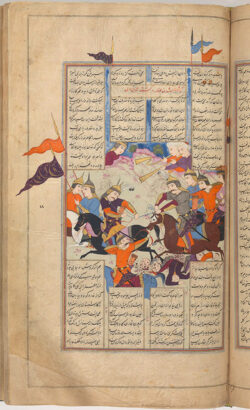
© The Metropolitan Museum of Art
From a layout point of view, images are arranged in the center of the folios and are contained in their upper and lower parts by the text. This type of layout where equal space is devoted to the images and the text is uncommon for the period. It is true that since the middle of the sixteenth century, starting with the Shahnama of Tahmasp (1522-1535), then with the one of Ismail II (1577-1578), page layouts tend to give a predominant place to the image. This type of layout grows beyond the century and finds its culmination in Muhammad Yusuf and Muhammad Qasim’s Shahnamas of Windsor and Rashida, which contain mostly folios with full-page images without any margin and few text blocks. Consequently, smaller images such as those in the manuscript production of Mu’in Musavvir could be considered as a more ancient approach, although Mu’in tends to paint over the margins on some occasions in case more space is needed for the scenes. While such a method is useful to convey a greater impression of dynamism, it isn’t always used in the same extent as can be seen in the two following groups. The first group comprises the Shahnamas made in the early 1650s, whose images are significantly bigger and overflow the frame. In some cases, the action takes entirely place in the margins. This ingenious idea makes it possible for Mu’in to solve technical difficulties due to insufficient space on the folio. The second group comprises the Shahnamas from the late 1660s onwards with a more conventional layout and smaller images protruding a little beyond the frame.
Regarding the figures and their treatment, we note the use of a very graphic fluid line that gets ticker or lighter to signify the volumes, especially regarding clothing. Such practice was already discernible in the works of Rezâ-ye ‘Abbâsi but is developed with a greater sense of dynamism in Mu’in’s work and results in an impression of drawn-like figures, which allude to the album paintings that are being produced in the same years. The contamination between album paintings and manuscript paintings can also be seen in the way the figures are depicted: they stand on their own, hold small objects or strike a pose. They seem to evolve in their own world rather than taking part in an action.
As for the palette, we note the recurring use of typical seventeenth-century colors like delicate pastels with an emphasis on orange, mauve, and pink. These tend to be brighter and stronger with abundant use of gold in the first group of manuscripts, i.e. in the 1650s, whereas the ones from after 1660, have duller colors. We note that the change of the palette is concomitant with the simplification of the layouts.
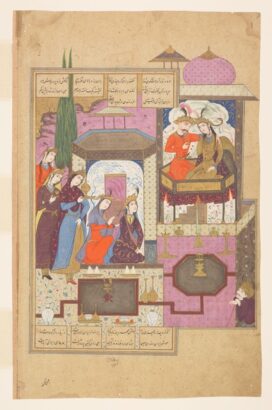
©The Trustees of the Chester Beatty Library

Unkown location
Therefore, one can suggest that the Shahnamas produced after 1660 are less ambitious. One might wonder if the inferior quality of these manuscripts could be related to the fact that they were intended for another kind of patron or maybe no patron at all and are meant to be sold in Esfahan’s bazaar? From this observation, it would be possible to distinguish two types of dynamics in the Shahnama production of Mu’in Musavvir; one being refined orders made for specific individuals from the aristocracy, the other being more generic books that can be sold with greater ease and for a lesser price.
Appendix
Catalog of known Shahnamas produced in the middle of the 17th century.
- Ferdowsi, Shahnama, ca.1640, 28 paintings, not signed, attributed to Mu’in Musavvir, London, British Museum, I.O. Islamic 1256.
- Ferdowsi, Shahnama, 1058/1648, 148 paintings, Muhammad Hakim al-Husayni, Malik Husayn Isfahani, Muhammad Qasim, Muhammad Yusuf, Ali Ashraf, Windsor Castle, Royal Library, RCIN 1005014.
- Ferdowsi, Shahnama, ca.1650, 143 paintings, not signed, Saint-Petersburg, Oriental Institute of the Academy of Sciences, D.377.
- Ferdowsi, Shahnama,, November 1652, 12 paintings, not signed, attributed to Mu’in Musavvir, Geneva, Musée d’art et d’histoire, 1971-0107-lm
- Ferdowsi, Shahnama, 1640-1660, 50 paintings, not signed, attributed to Mu’in Musavvir, Saint Petersburg, National Library of Russia, M.S. PNS 381.
- Ferdowsi, Shahnama, ca 1650, London, Victoria and Albert Museum, 44 paintings, not signed, 691-1896.
- Ferdowsi, Shahnama “Rashida“, ca.1650, 93 paintings, attributed to Muhammad Qasim, Muhammad Yusuf, Tehran, Golestan Palace Library, MS 2239.
- Ferdowsi, Shahnama, 1650, 99 paintings, unsigned, Manchester, John Rylands Library, MS 909.
- Ferdowsi, Shahnama, 1060/1650, 42 paintings (known), Mu’in Musavvir, dispersed, Copenhague, David Collection, 217.2006
- Ferdowsi Shahnama, 1052-1061/1642-1651, 192 paintings, Rezâ-ye Mosavver, Pir Muhammad al-Hâfez, Afzal al-Husayni, Saint-Petersbourg, Public Libary, M.S 333.
- Ferdowsi, Shahnama, 1054/1654, 30 paintings, Mu’in Musavvir, Toronto, Aga Khan Museum, AKM274.
- Ferdowsi, Shahnama, 1066/1655, 22 paintings, Mu’in Musavvir, Dublin, Chester Beatty Library, P.270.
- Ferdowsi, Shahnama, 1067/1657, 37 paintings, not signed, Dublin, Trinity College Library, M.S. M.2.1.
- Ferdowsi, Shahnama, 1660s, 34 paintings, Mu’in Musavvir, dispersed, New York, Metropolitan Museum, 1974.290.43.
- Ferdowsi, Shahnama, 1073/1663, 68 paintings, not signed, Paris, Bibliothèque Nationale de France, Supplément persan 499.
- Ferdowsi, Shahnama, 1077/1666, Mu’in Musavvir, dispersed.
- Ferdowsi, Shahnama, 1079/1669 (text), 1104/1693 (images), 42 paintings, Mu’in Musavvir, Fazl’Ali, Âqâ Noyân, Âli Naqî, Pir Beg, dispersed, New York, Metropolitan Museum of Art, 13.228.17.
Bibliography
[1] BREND, B, MELVILLE, C, Epic of the Persian Kings. The Art of Ferdowsi’s Shahnameh. London, Tauris, 2010, p.15.
[2] ) KEYVANI, M, Artisans and guild life in the later Safavid period: contributions to the social-economic history of Persia, Ph.D. thesis, Berlin, K. Schwartz, 1982, p.43
[3] CHARDIN, Jean, Voyage de Paris, Ispahan, Paris, Le Normand, 1811, book7, p.330. MUNSHÎ, Torkmān Iskandar-beg, Târîkh-i ‘Âlam-ârâ-yi ‘Abbâsi, (trad Roger Savory), Colorado, Westview Press, 1978, p.12.
[4] CHARDIN, Jean, Voyage de Paris, Ispahan, Paris, Le Normand, 1811, Book 7, p.333.
[5] M.T. NASRABADI, Tazkira-ye Nasrabadi, Tehran, 1317/1938, p.140.
[6] SIMPSON, M.,S.,, «The Making of Manuscripts and the Workings of the Kitab-Khana in Safavid Iran», Studies in the History of Art, vol. 38, 1993, p.112.
[7] CHARDIN, 1811, Book 7, p.333.
[8] TAYLOR, Alice, Book Arts of Isfahan. Diversity and Identity in Seventeenth-century Persia, Malibu, The J. Paul Getty Museum, 1995, p.13: “Merchands buy each page of my work for three tumans… Don’t sell them any cheaper”.
[9] ROBINSON, B.W., SIMS, E., The Windsor Shahnama of 1648, London, Azimuth, 2005, p.200.
[10] MATTHEE, Rudi, Persia in Crisis: Safavid decline and the fall of Isfahan, London, Tauris, 2012, p.40
[11] MUNSHÎ, Torkmān Iskandar-beg, Târîkh-i ‘Âlam-ârâ-yi ‘Abbâsi, (trad Roger Savory), Colorado, Westview Press, 1978, p.1260.
[12] BABAIE, S, FAHRAD, M., BABAYAN, K., Slaves of the Shah: New Elites of Safavid Iran, New York, Londres, I.B. Tauris, 2004, p.81.
[13] Reference is made here to the Shahnamas Windsor and Rashida completed in 1648. See CHAGNON, M., The Illustrated Manuscript Tradition in Iran,1040s/1630s-1070s/1660s: Patronage, Production, and Poetics in the Age of the “Fresh Style”, Dissertation, New York University, 2015.
[14] Moya Carey, Curator of the Islamic Collections at the Chester Beatty Library in Dublin, proposes to consider the 1655 Shahnama in two volumes conserved in the Chester Beatty Library and in the Aga Khan Museum in Toronto as an order of the great vizier of ‘Abbâs II, Kalifa Soltan. Mu’in Musavvir already worked for him painting his portrait in the same years (Freer Sackler Gallery, inv, LTS1995.2.88)
[15] AFSHAR, Iraj, Yadgarha-ye Yazd, Tehran, 1969, p.105



